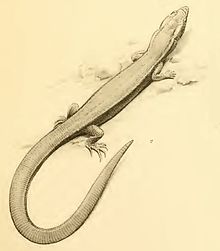
Leiocephalidae, also known as the curlytail lizards or curly-tailed lizards, is a family of iguanian lizards restricted to the West Indies. One of the defining features of these lizards is that their tail often curls over. They were previously regarded as members of the subfamily Leiocephalinae within the family Tropiduridae. There are presently 29 known species, all in the genus Leiocephalus.

Lepidophyma is a genus of lizards, commonly called tropical night lizards. The genus Lepidophyma is one of three genera of night lizards, which are a group of viviparous (live-bearing) lizards. There are 20 species of tropical night lizards in the genus Lepidophyma, making it the most populous night lizard genus. Species of the genus Lepidophyma are distributed throughout Central America, found anywhere from central Mexico to Panama, depending on the particular species. Tropical night lizards, particularly the yellow-spotted species, are sometimes called Central American bark lizards by pet dealers and owners.

Eleutherodactylus is a genus of frogs in the family Eleutherodactylidae. Many of the 200 species of the genus are commonly known as "rain frogs" or "robber frogs", due to their sharp, high-pitched, insect-like calls.

Lirainosaurus is a genus of titanosaur sauropod which lived in what is now Spain. The type species, Lirainosaurus astibiae, was described by Sanz, Powell, Le Loeuff, Martinez, and Pereda-Suberbiola in 1999.
Lisboasaurus is a small genus of Mesozoic crocodylomorph that lived in fresh water. It is known from fossilized tooth and jaw fragments of Late Jurassic and Early Cretaceous age. Two species have been described. In the past Lisboasaurus has been interpreted as an avialan, troodontid, or an anguimorph lizard. Both species are currently assigned to Crocodylomorpha, one is reassigned to the genus Lusitanisuchus.
María de Estrada was a Spanish woman who participated in the expedition of Hernán Cortés to Mexico in 1519–24. She traveled as a conquistador and fought there. There is also some evidence that she had previously spent several years as a castaway among the native inhabitants of pre-colonial Cuba.
Tropidophis celiae, commonly known as the Canasi dwarf boa or the Canasi trope, is an endangered species of dwarf boa, a snake in the family Tropidophiidae. The species is endemic to Cuba.
Eleutherodactylus varians is a species of frog in the family Eleutherodactylidae. It is endemic to Cuba and occurs in the central and eastern parts of the main island as well as on the Isla de Juventud. Common names cliff robber frog and Cuban bromeliad frog have been proposed for it. Eleutherodactylus olibrus and Eleutherodactylus staurometopon are sometimes included in this species as subspecies.
Víctor Miquel Moreno Piñeiro, known as Victor Moreno was a Cuban painter. He was born in Placetas, Villa Clara, Cuba and died in Havanna, Cuba.

Amphisbaena is a genus in the family Amphisbaenidae, commonly known as worm lizards. Over 100 species are placed in this diverse genus.

Liolaemus chiliensis is a species of lizard in the family Liolaemidae, also referred to as the weeping or crying lizard in English. Synonyms for this species include "Liodeira chilensis" and Calotes chiliensis." Less commonly, it is called the Talcahuano Smooth-throated Lizard.

Cayo Hueso is a consejo popular (ward) in the municipality of Centro Habana, Havana, Cuba. A traditionally working-class neighborhood populated by Afro-Cubans, it is known for its many cultural landmarks such as the Callejón de Hamel, the Fragua Martiana Museum and the Parque de los Mártires Universitarios.
Sphaerodactylus armasi, also known commonly as the Guantanamo coastal gecko or the Guantanamo least gecko, is a species of lizard in the family Sphaerodactylidae. The species is endemic to Cuba.
Una rosa de Francia is a 2006 Spanish–Cuban romance and adventure film directed by Manuel Gutiérrez Aragón which stars Jorge Perugorría, Álex González, Broselianda Hernández and Ana de Armas.








